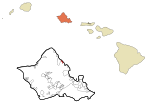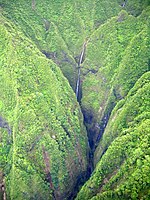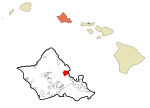Kaʻaʻawa, Hawaii

Kaʻaʻawa is a small community and census-designated place (CDP) located in the windward district of Koʻolauloa, City & County of Honolulu on the island of Oʻahu, Hawaiʻi, United States. As of the 2010 Census, the total population for Kaʻaʻawa was 1,379. In Hawaiian, kaʻaʻawa means "the wrasse (fish)". From the Hawaiian spelling Kaʻaʻawa it is seen that each a is pronounced separately and distinctly, set apart by the two ʻokinas: [ˈkɐʔəˈʔɐvə] or [ˈkɐʔəˈʔɐwə]. Kaʻaʻawa is north of Kāneʻohe Bay (north of Kaʻōʻio Point, also Kalaeokaʻōʻio), and the Pacific Ocean shore here is fronted by a broad fringing reef with a narrow, but quite inviting beach (Kanenelu Beach, Kalaeʻōʻio Beach Park, and Kaʻaʻawa Beach Park). The around-the-island-highway (Kamehameha Highway, State Rte. 83) and the houses and other buildings comprising the town, are confined to a relatively narrow belt along the coast. However, a long valley extends inland. Kaʻaʻawa Valley is part of Kualoa Ranch and used for various tourist activities as well as filming. Major films and TV series incorporating significant views of the valley include George of the Jungle, Jurassic Park and Lost. The U.S. postal code for Kaʻaʻawa is 96730.
Excerpt from the Wikipedia article Kaʻaʻawa, Hawaii (License: CC BY-SA 3.0, Authors, Images).Kaʻaʻawa, Hawaii
State Highway 83,
Geographical coordinates (GPS) Address Nearby Places Show on map
Geographical coordinates (GPS)
| Latitude | Longitude |
|---|---|
| N 21.556944444444 ° | E -157.85527777778 ° |
Address
State Highway 83 (Kamehameha Highway)
State Highway 83
96730
Hawaii, United States
Open on Google Maps











